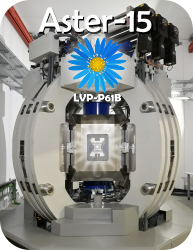 Aster-15, installed at P61B, is the world’s first 6-rams-LVP operated at a synchrotron facility. This type of instrument offers deformation capability, precise control of the anvil positions and high efficiency of pressure generation.
Experiments at extreme conditions of high pressures and temperatures are possible in various modes using a combination of 6 first-stage anvils and 6 or 8 second-stage anvils (6-6 and 6-8 compression geometries, respectively). Using the 6-8 mode with tungsten carbide second stage anvils, pressures up to 30 GPa can be generated at the expense of a smaller anvil gap, up to 10 degrees for diffracted X-rays. Alternatively, the 6-6 mode offers a wider anvil gap, particularly up to 27 degrees in the vertical plane for diffracted X-rays, but the maximum sample pressure is limited to about 15 GPa. Also, controlled deformation of samples is only possible in 6-6 mode using 2 Ge-detectors.
Aster-15, installed at P61B, is the world’s first 6-rams-LVP operated at a synchrotron facility. This type of instrument offers deformation capability, precise control of the anvil positions and high efficiency of pressure generation.
Experiments at extreme conditions of high pressures and temperatures are possible in various modes using a combination of 6 first-stage anvils and 6 or 8 second-stage anvils (6-6 and 6-8 compression geometries, respectively). Using the 6-8 mode with tungsten carbide second stage anvils, pressures up to 30 GPa can be generated at the expense of a smaller anvil gap, up to 10 degrees for diffracted X-rays. Alternatively, the 6-6 mode offers a wider anvil gap, particularly up to 27 degrees in the vertical plane for diffracted X-rays, but the maximum sample pressure is limited to about 15 GPa. Also, controlled deformation of samples is only possible in 6-6 mode using 2 Ge-detectors.
Contact the beamline if you do not have any resources but wish to conduct (in situ) high-PT LVP experiments on scientifically interesting materials. Other information about the beamline can be found in the menus on the left. If you have any questions, please do not hesitate to contact the beamline manager, Dr. Robert Farla.
Contents
I. Collaborative or independent beam/experiment time?
Prior to your first visit, please decide whether or not you require collaborative assistance for preparation and execution of your experiments at P61B. Upon your arrival please discuss your desired choice with the head of the beamline (Dr. R. Farla) and the beamline scientist who is your local contact.
We, the beamline staff, are happy to help you in any way possible to ensure the success of your experiments. We can advise you on high-pressure techniques, X-ray techniques and in many cases, the scientific objectives of the project.
For those who are offered beam/experiment time for an excellent science case, but do not have a high-pressure laboratory at their home institute, resources and experience with high-pressure/X-ray techniques, we hope you will consider our contributions to the success of your beam/experiment time.
→ If you welcome our participation (before) and during your beam/experiment time, please tell us! Please also consider us after your beam/experiment time and include us in the writing of a manuscript. Please offer us at least 1 week to review the manuscript as co-authors. Thank you!
→ If you prefer to work independently during your beam/experiment time, and do not require any particular assistance or discussions, please also let us know! Of course, your local contact is available to help you (except generally between 22:00 - 08:00) in case of problems with the acquisition software or other technical issues, such as malfunctions with the LVP or heating system.
Thank you for your kind consideration! We wish you a fruitful beam/experiment time and high-quality publishable data.
II. Flowchart for experiments using the 6-ram LVP
The Aster-15 (mavo LPQ6-1500-100) Large Volume Press at P61B accepts a large range of assemblies for experiments with and without synchrotron X-rays. Here is a handy flowchart for choosing the right set up for your extreme conditions experiment in the LVP.

Click on the image to see the chart in a larger resolution. The faded elements in the chart are not (yet) available, but are planned. For all assemblies in the 'black cups', the beamline can offer material resources to those who lack them. For all 'regular' experiments, steel 60-mm first-stage anvils (FSA) are used. For special experiments (e.g. for ultra-high pressure or for smaller 'Japanese-style' WC anvils, 26-mm size), other compatible FSA are available upon early request.
III. Beamline offer for cell assemblies
Depending on your choice above (collaborative or independent work), the beamline can offer certain resources for experiments, especially if you do not have any resources for LVP experiments.
The following resources are needed to carry out experiments (with X-rays) in the LVP:
- WC anvils (for MA6-8 'Kawai' or for MA6-6 'cubic' assemblies)
- Pyrophyllite preformed gaskets (using CNC)
- Ceramic cell assembly parts and heater
- Glass-epoxy insulation sheets
- Thermocouple wire
- X-ray transparent B-epoxy blocks / amorphous BCN materials
Material support for experiments requires a lot of preparation/machining time for the beamline staff (of 2 members). Therefore, communicate early (at least 2 months before beam/experiment time) your needs.
If you need anvils, we can make an offer. Pressure must be limited to a maximum of 20 GPa for your experiments (10/4 assembly). Above 20 GPa, anvils break significantly faster, and the beamline cannot cover an increase in these costs right now. When using beamline anvils, please throroughly discuss your cell assembly design with the beamline staff / Dr. R. Farla. You must get our approval to use your own assembly with beamline anvils. We will also ask you to take more time to decompress your experiments, even during beam time, in order to extend the life of the anvils!
Shown below is the design of our standard cell assemblies for experiments without X-rays.






